the railways in yeovil
pen mill station
Opened 1854 and still operating
Pen Mill railway station was opened by the Great Western Railway (GWR) (incorporated 1835, nationalised 1948) as part of the Wilts, Somerset and Weymouth Railway (WS&WR) route on 2 February 1854, with a branch to Hendford completed the following year. In fact the WS&WR had begun construction on a line between Westbury and Dorchester in 1846 but got into financial difficulties, but work was completed on the Westbury to Frome section which opened in 1850. The GWR took over the WS&WR when the company was dissolved the same year.
Pen Mill Station was built in the eastern end of a field called Great Medway (Parcel 865).
By 1856 work was progressing on the 26-mile section between Frome and Yeovil, with stations at Witham, Bruton, Castle Cary, Sparkford and Marston Magna and it opened in the September. In 1857 the Yeovil to Weymouth line opened, together with the branch line between Maiden Newton and Bridport.
The WS&WR was a broad gauge railway that linked the GWR at Chippenham, Wiltshire, with Weymouth, Dorset. The line passed through Yeovil at Pen Mill Station. The majority of the line survives today as the Wessex Main Line and the Heart of Wessex Line.
As Daniel Vickery wrote in 1856 “The Wilts, Somerset and Weymouth railway is rapidly approaching completion; and when finished, will afford communication with all parts of England, Scotland and Wales. The proposed central station will be at Pen-mill.” The Great Western Railway opened a locomotive depot at the station in September 1856.
In 1860 the Salisbury and Exeter line opened a station at Yeovil Junction with an extension to Hendford and the new Town Station the following year and a goods line connected Yeovil Junction with Pen Mill in 1864.
The Pen Mill locomotive depot operated until January 1959, when it was closed and the locomotives transferred to Yeovil Town depot. Long-distance trains from Pen Mill had ceased in September 1961 leaving only Yeovil Junction with a service to London. The service between Yeovil Junction and Pen Mill was also withdrawn from 5 May 1968.
The route between Yeovil Town Station and Pen Mill Station has been incorporated into the National Cycle Network and is known as Railway Walk.
maps
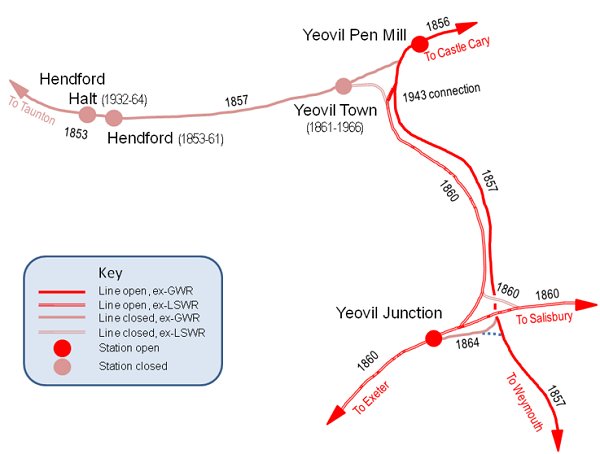
Sketch plan of Yeovil's somewhat complex railway network showing the relative locations of Yeovil Town, Pen Mill and Junction stations, Hendford terminus and Hendford Halt. Click on any station name to open its page.
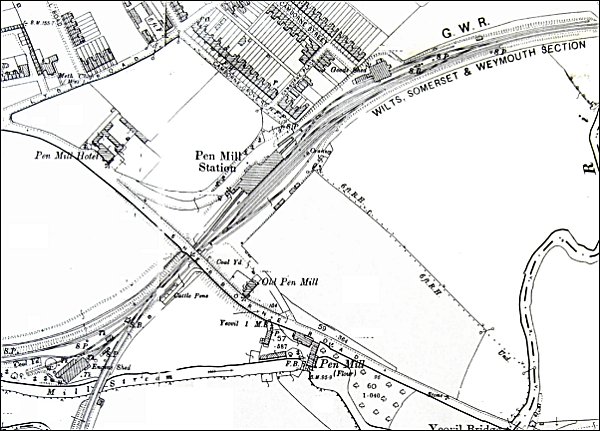
This map, based on the 1901 Ordnance Survey, shows Pen Mill Station at centre. At top, right of centre, is the station's goods shed, between the Old Pen Mill and the railway track is the station's coal yard and on the other side of the road are the cattle pens. At bottom left is the station's engine shed, turntable (still visible today) and another small coal yard.
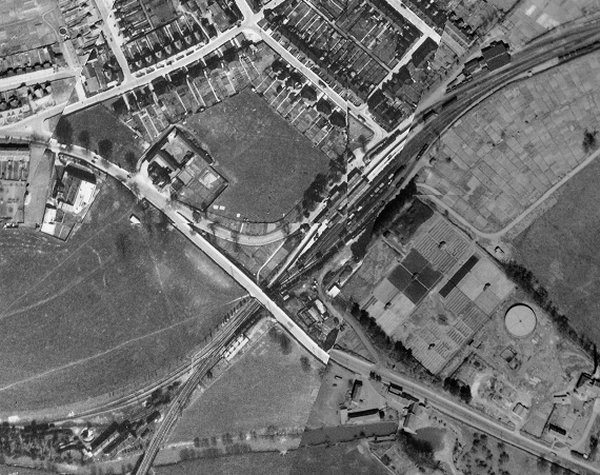
The 1946 aerial photograph covering the same area as the 1901 map above and showing the same features, from the goods shed to the turntable.
gallery
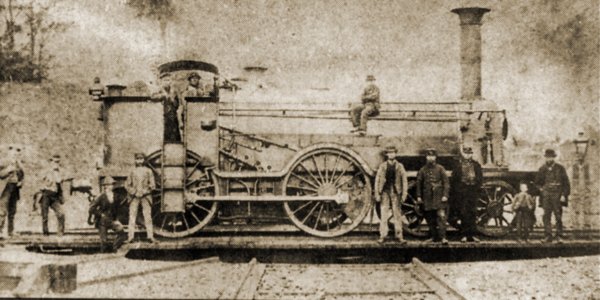
This photograph
features in my
book "Yeovil
In 50 Buildings"
A photograph of around 1860 showing a Bristol & Exeter Railway broad gauge 4-4-0 tank standing on the turntable apparently at Chard Joint Station but, nevertheless, the type of tank used at the time.
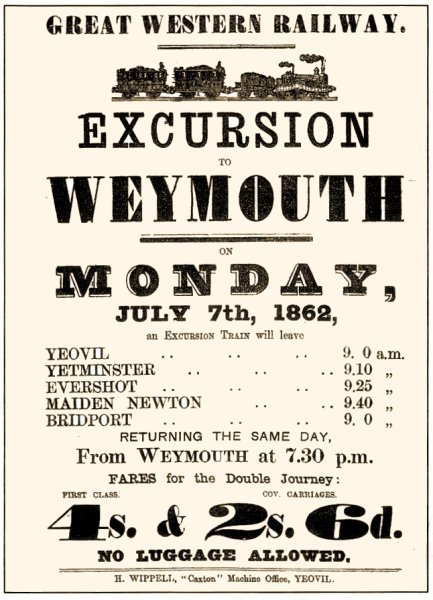
Day trips by train soon caught on, with a First Class return fare being the equivalent of just over £16 at today's value.
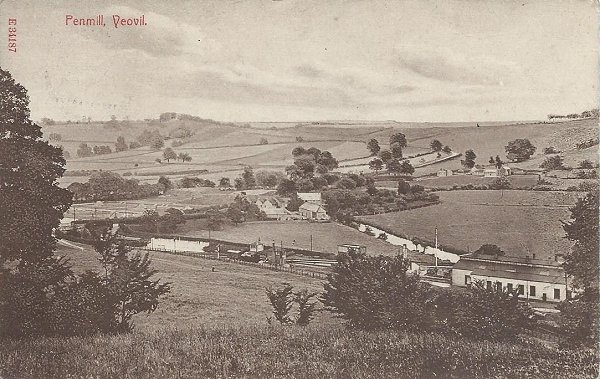
From my
collection
-
This photograph
features in my
book 'Yeovil
From Old
Photographs'
A postcard of about 1910 looking southeast and showing Pen Mill (that is, the mill not the station) at centre. At bottom right is the Pen Mill Station engine shed (see next four photos) and the signal box just below and to the left of the mill at centre. Between the engine shed and the mill is the mill stream and the Sherborne Road runs from just above centre left to the mill. Pen Mill Station is off image to the left.
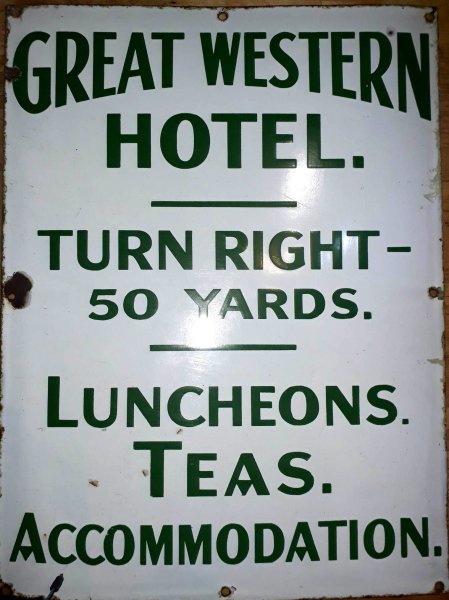
Courtesy of Tony
Rendell
An enamel sign that was once displayed in Pen Mill Station, advertising the Great Western Hotel which was literally just around the corner.
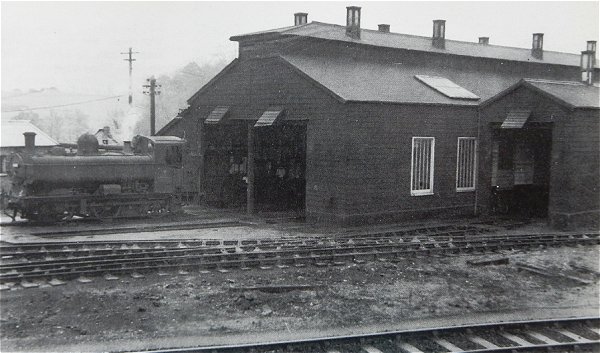
The Pen Mill engine shed photographed in 1958, shortly before its closure and demolition.
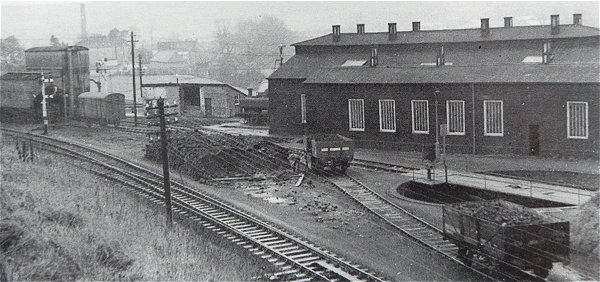
.... and seen from a different angle. The line in the lower left quadrant is the Pen Mill to Yeovil Town branch line.
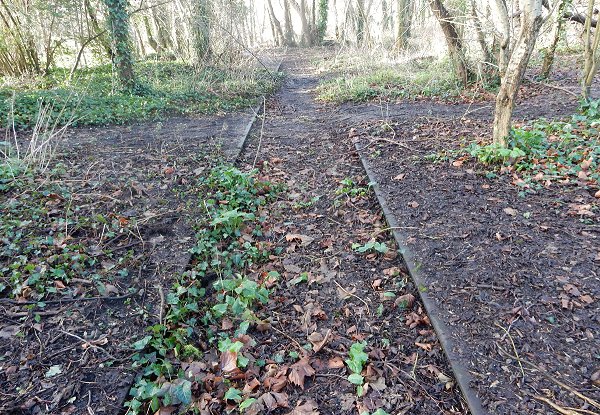
These surviving tracks were originally within the Pen Mill engine shed. Photographed in 2016.
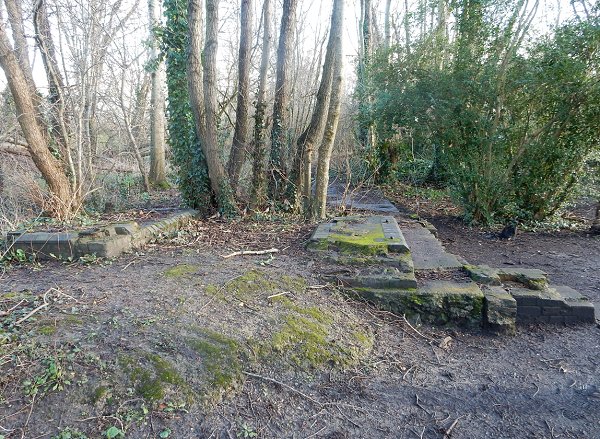
The remains of the Pen Mill engine shed. Photographed in 2016.
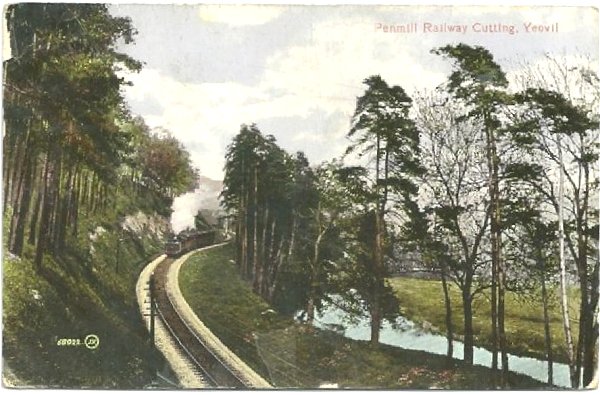
From my
collection
A hand-coloured postcard dated 1918 of the Pen Mill cutting alongside Wyndham Hill (at left) with the River Yeo (at right). Today this is the footpath / cycle path known as Railway Walk.
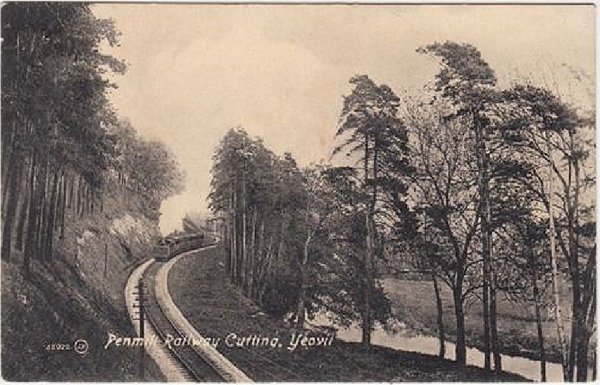
From my
collection
The same postcard as above but produced as a sepia print in the 1920s.
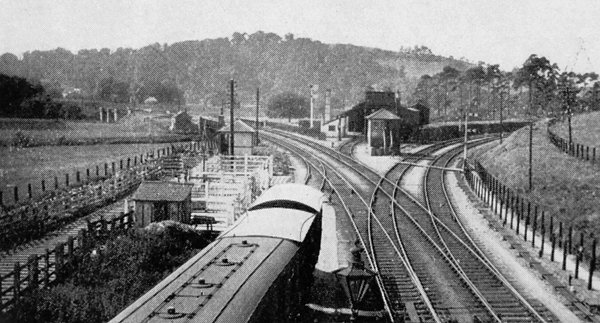
Pen Mill Junction photographed in the 1920s.
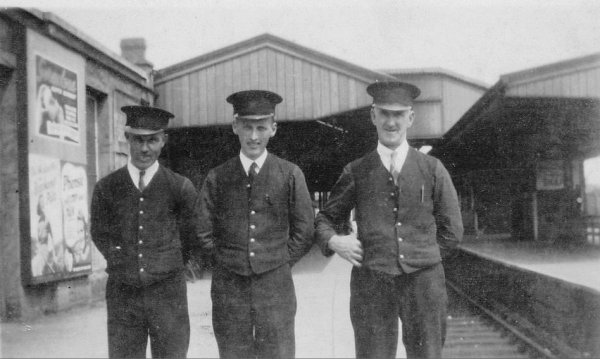
Courtesy of
Roger Froude
Pen Mill staff photographed in 1941. At left is Joe the porter, at centre is telegraphist Bill Froude and at right is the signalman (name unknown). For Bill Froude's railway memories click here.
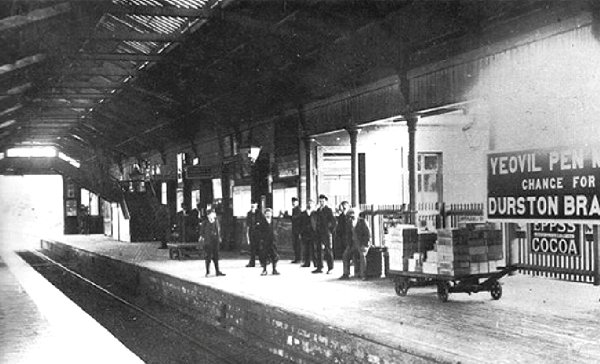
Pen Mill Station, photographed in the 1940s.
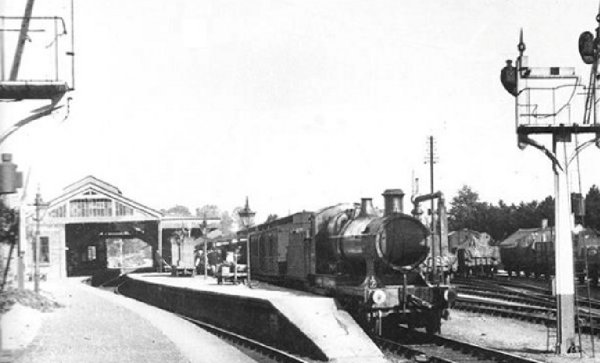
Pen Mill Station, photographed in the 1940s.
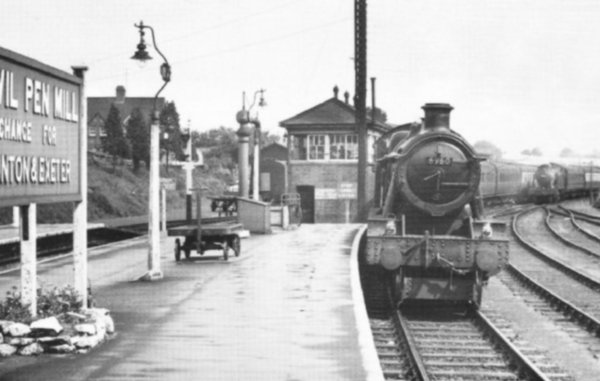
Pen Mill Station, photographed in 1958.
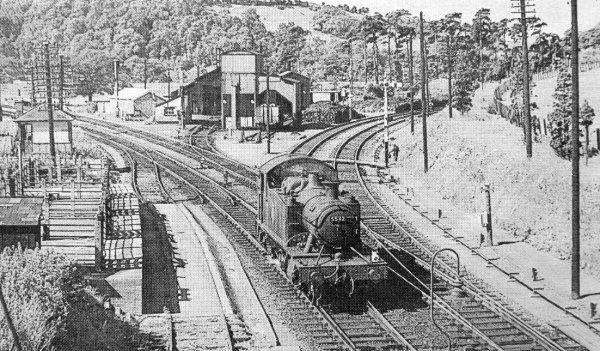
Courtesy of
Colin Haine
Lines at Pen Mill in 1956, as published in the Western Gazette.
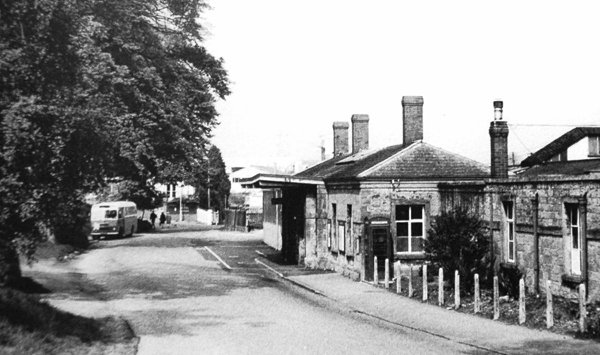
Pen Mill Station, photographed about 1960.
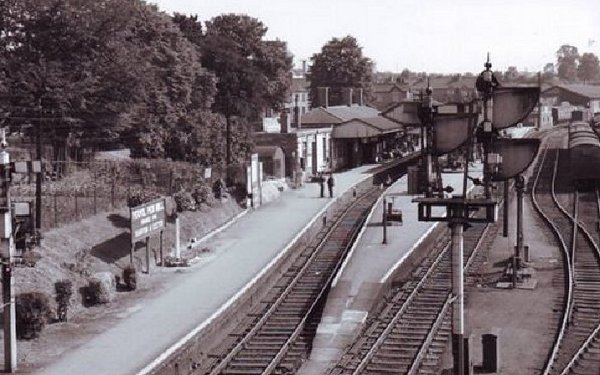
A postcard, dated 1956, showing Pen Mill Station as seen from the Sherborne Road bridge.
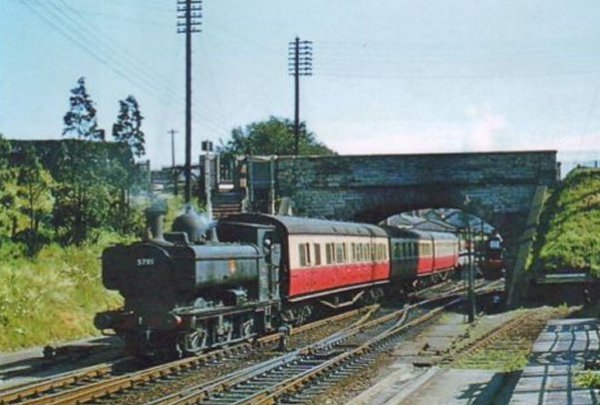
Another postcard of 1956, this time taken from Pen Mill platform looking towards Sherborne Road bridge.
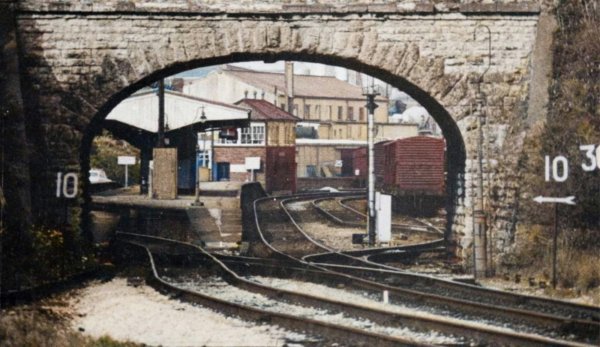
From my
collection
-
This colourised photograph
features in my
book 'Yeovil
From Old
Photographs'
A postcard of about 1960 showing an unusual view of Pen Mill station through the Sherborne Road bridge.
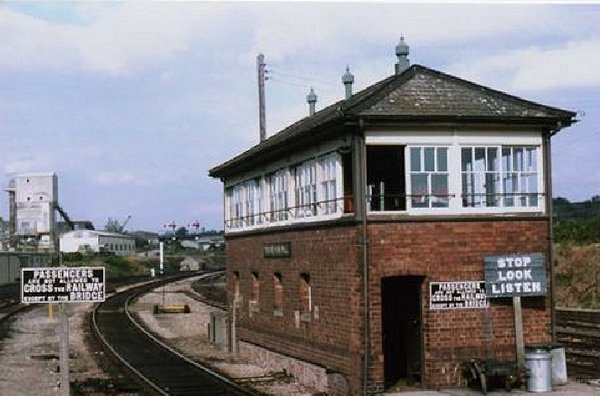
Pen Mill Station Box, photographed in 1976.
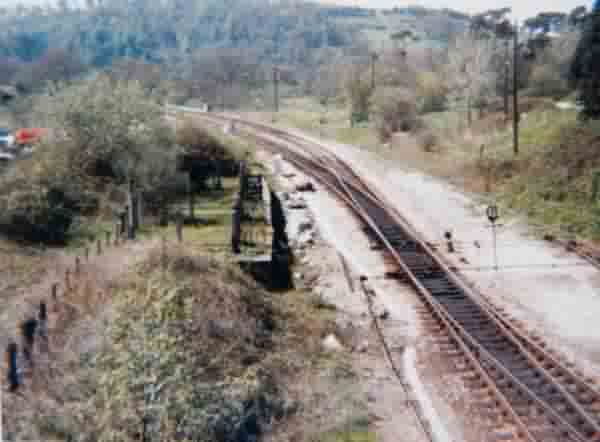
Courtesy of
Colin Haine
Disused cattle pens at Pen Mill station, photographed in 1988.
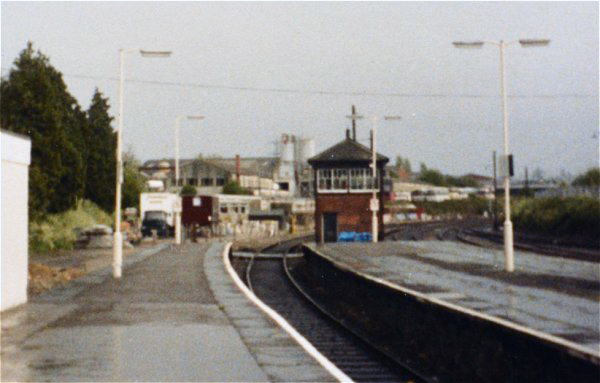
Courtesy of
Vivien and John
Cornelius
Pen Mill station photographed during the 1990s.
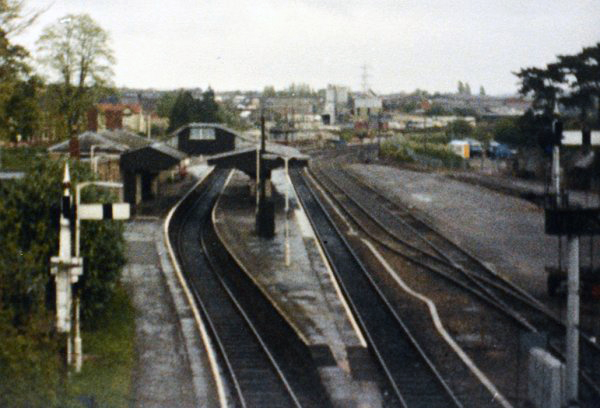
Courtesy of
Vivien and John
Cornelius
Pen Mill station, again photographed during the 1990s.
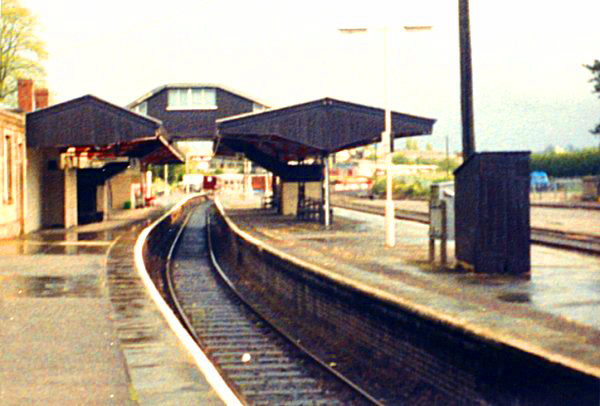
Courtesy of
Vivien and John
Cornelius
Pen Mill station, again photographed during the 1990s.
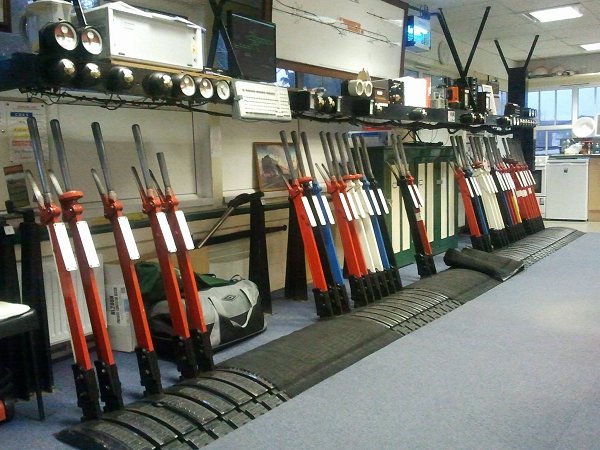
Courtesy of
Keith Peto
The interior of the Pen Mill signal box.
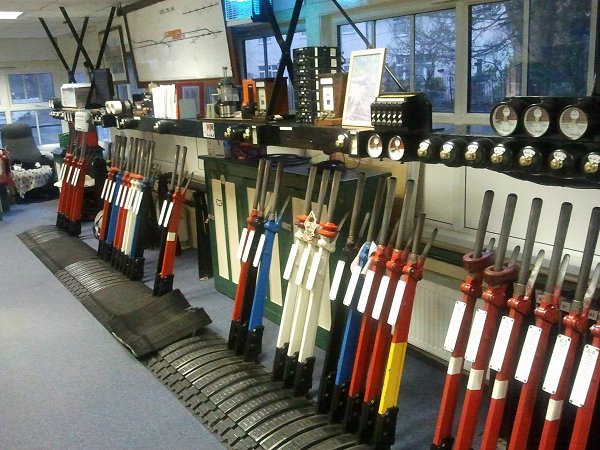
Courtesy of
Keith Peto
.... and looking the other way towards Thomas, the black-and-white signal box cat, asleep on the armchair at far left.
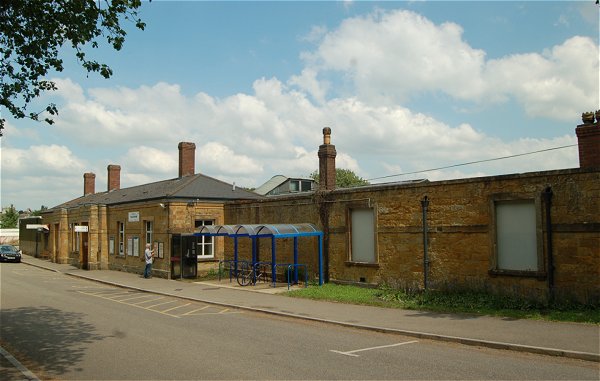
This photograph
features in my
book "Yeovil
In 50 Buildings"
Pen Mill Station photographed in 2014.
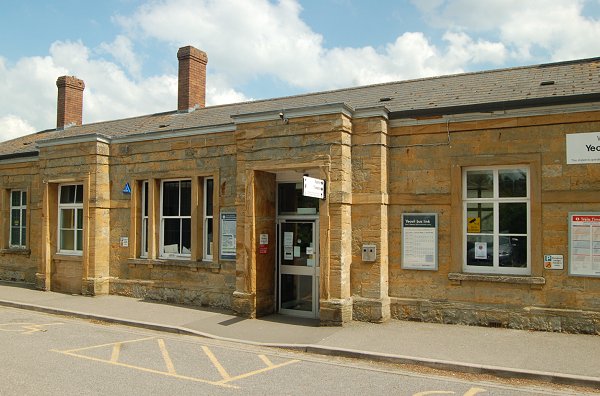
Detail of the entrance to the station, photographed in 2014.
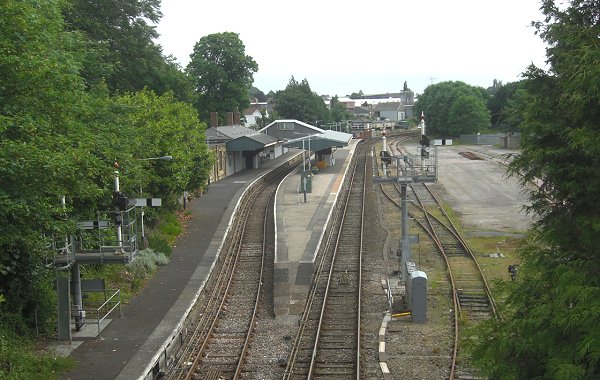
Pen Mill Station seen from Sherborne Road bridge. Photographed in 2014.
For the enthusiasts - Some Visitors to Pen Mill Station
Many thanks to Keith Peto for the following photographs of various locomotives at Pen Mill Station. (Apologies for my captions - they are the best I could nick from the interweb).
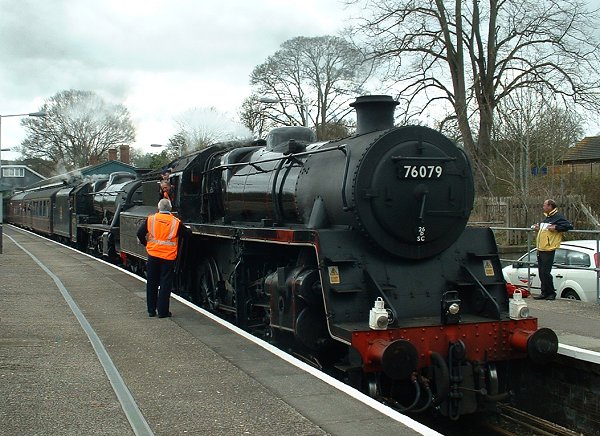
76079 was built at Horwich works in 1957 to a standard BR design of R A Riddles, and is owned by the East Lancashire Railway. Photographed 2006.
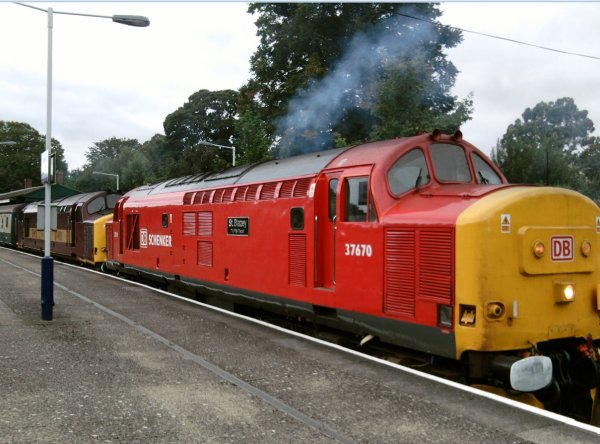
Class 37/5 No. 37670 "St Blazey" T&RMD (DB Schenker red). The first locomotives were turned out in Deutsche Bahn verkehrsrot (traffic red) livery after the purchase of EWS in 2007. Photographed 2009.
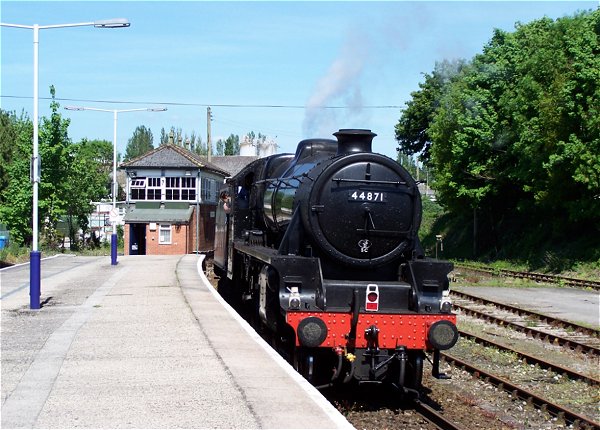
The London Midland and Scottish Railway Class 5 4-6-0, almost universally known as the Black Five, is a class of steam locomotive. It was introduced by William Stanier in 1934 and 842 were built between then and 1951. Members of the class survived to the last day of steam on British Railways in 1968, and eighteen are preserved. Eleven Black Fives, including 44871, have also been operated on the mainline in preservation. Photographed in 2010.
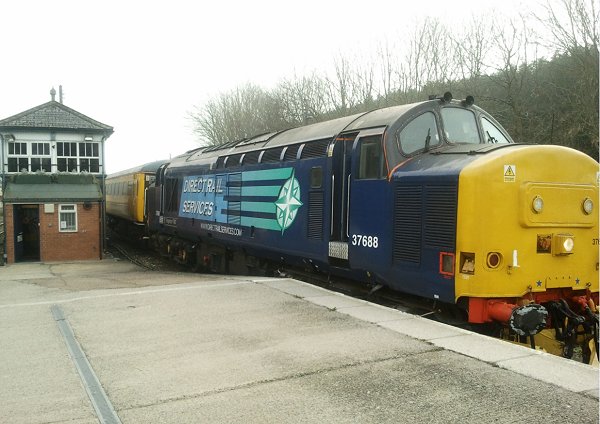
Direct Rail Services English Electric Type 3 Class 37 diesel locomotive 37688 'Kingmoor TMD'. Photographed 2012.
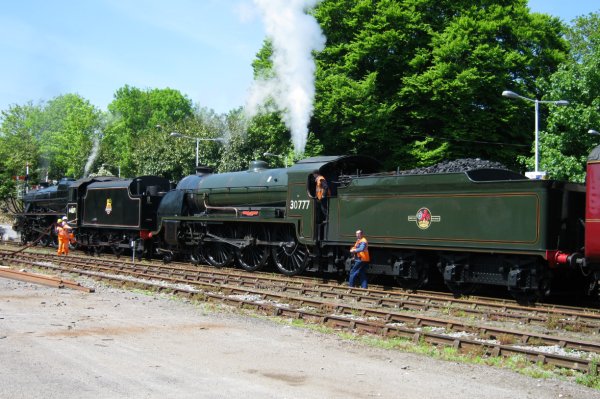
A double-header. Southern Railway King Arthur Class 4-6-0 No.30777 "Sir Lamiel" with, at left, 44871 - see above. Originally numbered E777, "Sir Lamiel" was built in June 1925 at the North British Locomotive Works in Glasgow as one of the batch of 30 engines. These engines had a narrower cab to suit them for use on the Eastern section of the Southern Railway and had 5000 gallon bogie tenders. Smoke deflectors were fitted in December 1927. Photographed 2010.
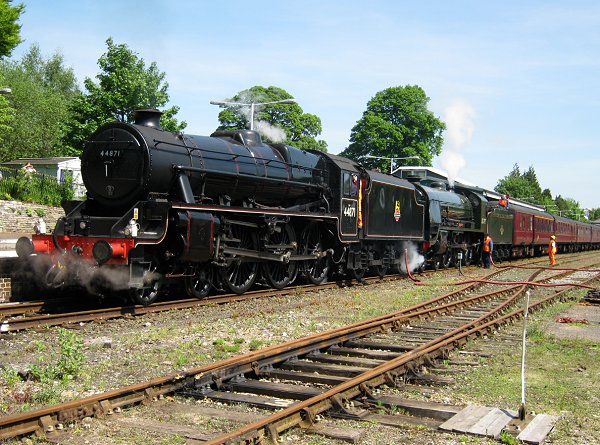
.... and 44871 and 30777 seen from the other direction. Photographed 2010.
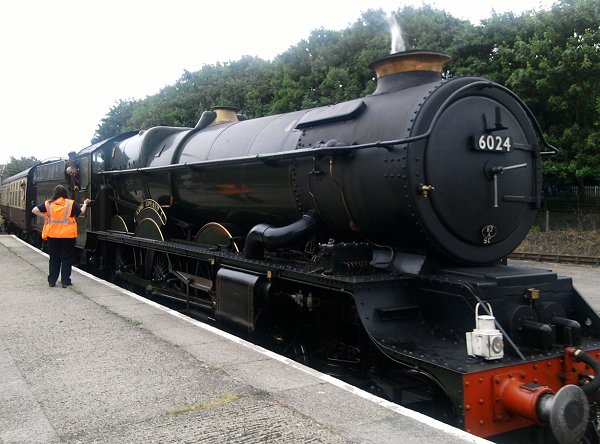
Great Western Railway 6000 Class 6024 "King Edward I" ran from 1930 to 1962 for the Great Western Railway and latterly British Railways hauling express passenger services. After withdrawal, it was sent to Woodham Brothers scrapyard in Barry, South Wales, where it remained for a number of years before being bought for preservation. It returned to steam in 1989 and has since been certified for mainline running.
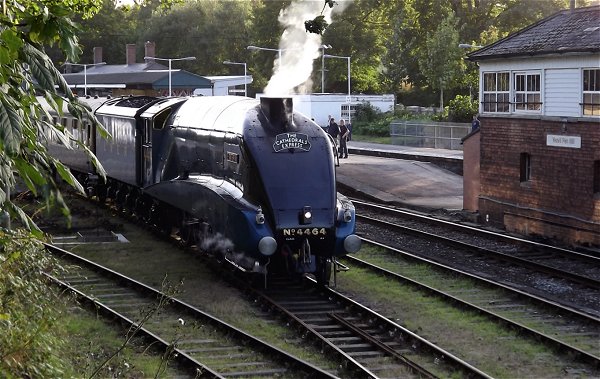
Steam Dreams' "Cathedrals Express", hauled by ex-LNER A4 class locomotive no 4464 "Bittern". Built for the LNER in 1937 at Doncaster Works as works number 1866, it was originally numbered 4464. Photographed 2012.
and finally. . .
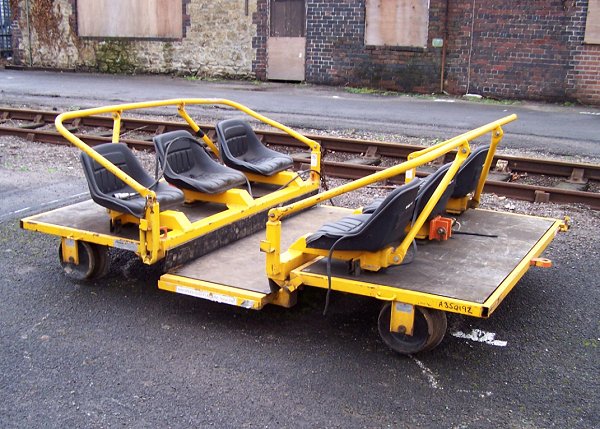
The new open-top summer express coach for Pen Mill to Weymouth day-trippers?